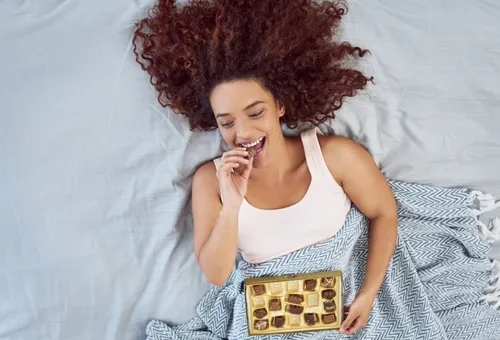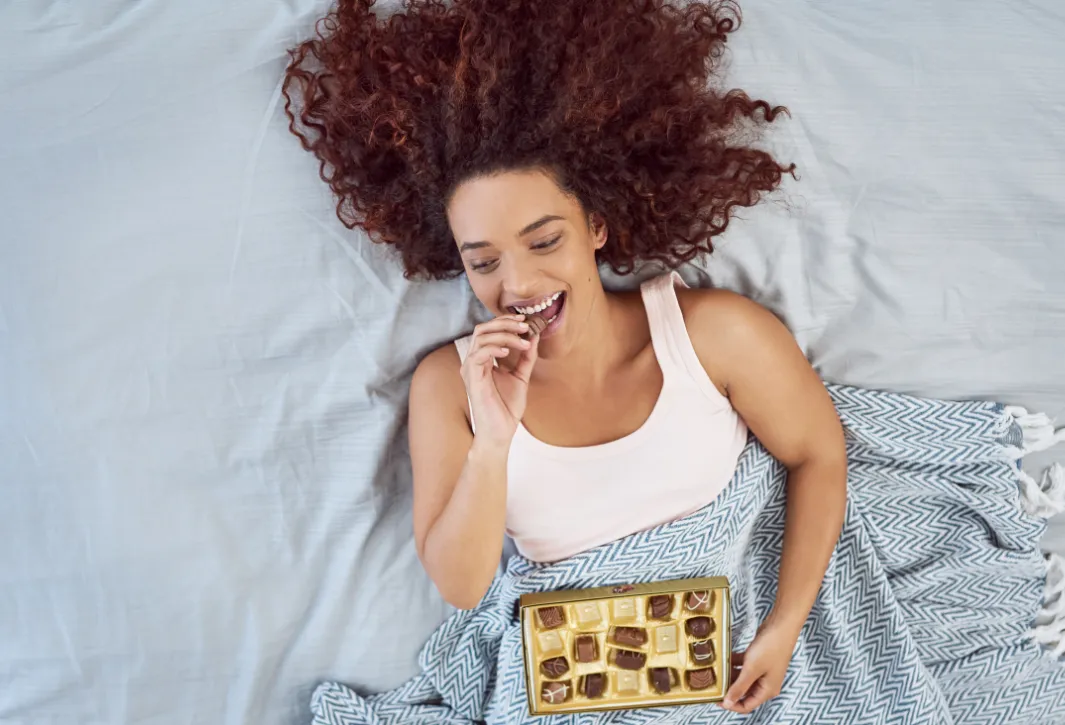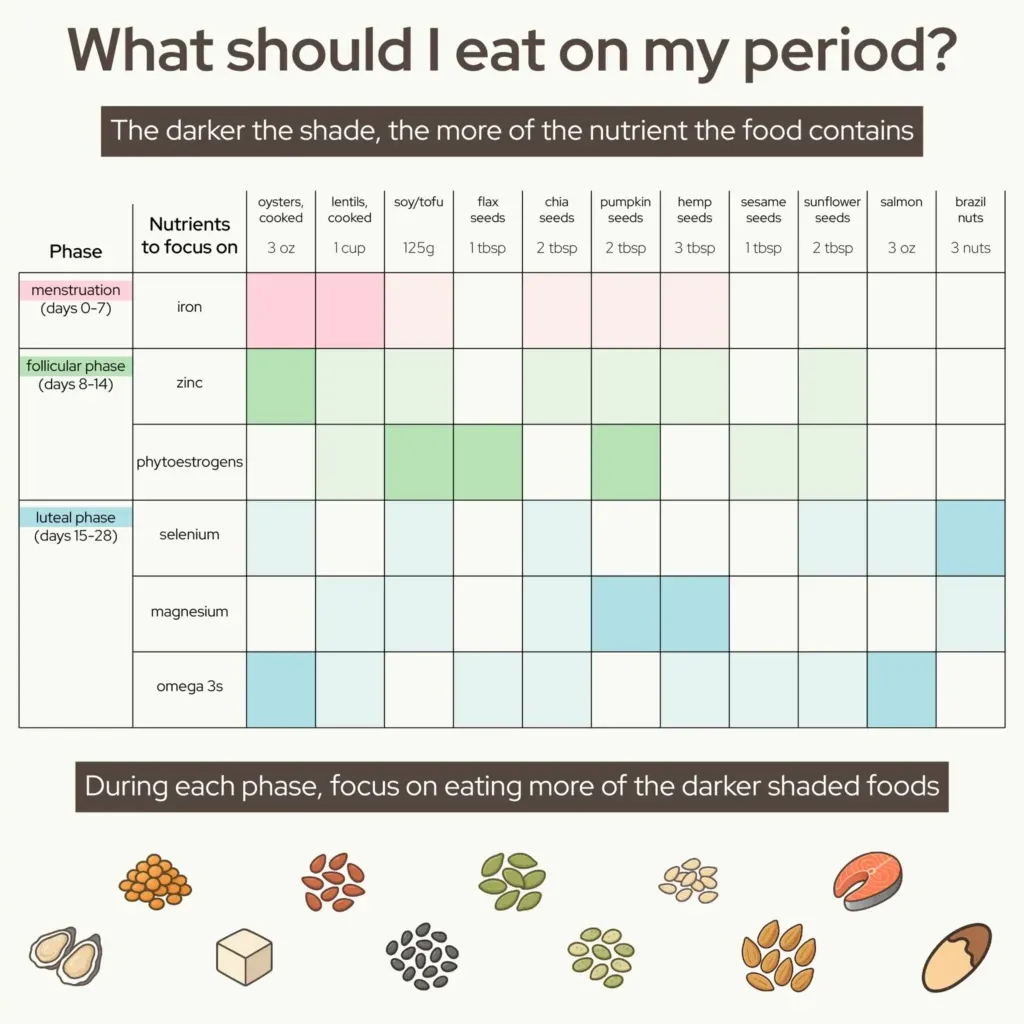Fri Aug 08 / Ashwini Achutharaman, RD Intern & Dr. Abrar Al-Shaer, PhD, RD
What Should I Eat on My Period?
Learn what to eat during each phase of your menstrual cycle to support hormone health, reduce cramps, and boost energy. A guide to key nutrients and foods that can improve your period experience.

Your period is one of the most intricately balanced processes that happens in your body. For a simple visual guide to understanding how your period works, follow along with our story of your period from the perspective of your egg cells. Think of your period as your body’s monthly report card. In order to get an A every month, your body requires certain nutrients, with each one serving a different purpose. Not getting the right amount of vitamins and minerals can throw off your internal balance and cause symptoms like period cramps. Read on to learn about some of the nutrients you should be focusing on during your period.
Can low iron affect your period?
Iron is one of the most important minerals in your body with many functions ranging from metabolism to immunity. One of its most crucial functions is to carry oxygen from your lungs to the rest of your body. Your cells can only perform optimally if they have enough oxygen, which is why people who suffer from low iron tend to be less energized. If you want to understand whether your iron levels are in check, read our blog Getting Proper Iron Testing: You May Have Low Iron and Not Know It.
Iron is even more essential for menstruating women. It regulates blood flow to your ovaries to ensure adequate nutrients are being delivered to the growing cell. Iron is also part of the process that breaks down hormones like estrogen and progesterone into other forms that your body can use.
Getting enough iron from your diet is important at all stages of your menstrual cycle, though you may want to increase your intake during the days that you are bleeding on your period to restore any iron lost in your blood. Foods that are rich in iron are oysters (6.9 mg per 3 oysters), sesame seeds (2.1 mg per tbsp), cooked spinach (6.4 mg per cup), and cooked lentils (3.3 mg per 1/2 cup) .
To maximize the amount of iron your body can absorb, pair iron-rich foods with vitamin C-rich foods. This could be as simple as a squeeze of lemon over your sautéed spinach, or cooking your lentils with tomatoes. In addition, for optimal iron absorption it is best to avoid having coffee/tea, calcium supplements, or high amounts of dairy, in the same meal.
Women should get a minimum of 18 mg of iron every day. Unfortunately, it can be difficult to get that from food alone. Take white beans for example: you would need to eat a little over 2 cups of beans every day to get the minimum amount of iron. To make the issue worse, recent studies have shown that modern farming practices and air pollution are making plants less nutrient-rich. In the last thirty years, iron content of vegetables has decreased by nearly 30 to 50 percent .
While it may seem difficult to get iron from food alone, there is one easy kitchen tool that can boost the amount of iron you get from meals you are already eating. Swapping your skillet for a cast-iron skillet has been shown to increase the iron content of a meal by 16% . You can also try the Lucky Iron Fish, a small block that is placed into food and releases 6-8 mg of iron into every dish you make with it .
If you are looking to add a supplement to meet your iron requirements, try to get one that has iron bisglycinate or iron chelate, as these are gentler on your stomach. Most of our favorite multivitamin options on Fullscript have iron already included. And, as a bonus, if you use our link you will receive a 20% discount on your order!
Zinc deficiency in women
Zinc helps your body protect itself against unwanted danger. It is used to support your immune system, help wound healing, and helps repair your DNA if it is damaged. Early in your cycle, when your egg and follicle are still developing, it protects them against harmful oxidative stress.
To understand the concept of oxidative stress, let us think about an avocado. Once you cut an avocado and leave it out, what happens? Its once vibrant green turns unpleasantly brown. But squeeze a hint of lemon juice over it and its vibrancy will last significantly longer. The browning of the avocado is an example of oxidative stress: damage done to your cells from exposure to unwanted particles in their environment. Antioxidants, like zinc or compounds in lemon juice, can protect against those unwanted particles and keep your body as fresh as the green avocado.

Additionally, Zinc is a key ingredient in testosterone synthesis. You need just the right amount of testosterone to help your follicles grow and take care of the egg. Zinc also signals certain cells to give your eggs nutrients to help them mature. Finally, zinc influences the production of LH and FSH which are the key hormones during the first half of your cycle.
Women should get a minimum of 9 mg of zinc daily and be careful not to exceed 34mg . Your needs for zinc are higher during the first half of your cycle as this is the time that your follicle and egg are maturing and need more protection and nourishment . Foods that are high in zinc include oysters (32 mg per 3 oysters), oatmeal (2.3 mg per 1 cup cooked), and cheddar cheese (1.5 mg per 1.5 ounces) .
What is selenium good for?
Selenium is a mineral that is often overlooked but is critical for reproductive health. Its main role is to support your thyroid, a powerful gland that has many functions throughout the body. Your thyroid is your body’s control center and is a key player in deciding whether or not you have a period. If your period has been missing or irregular, read our blog Why Have I Not Gotten My Period? to decipher the root cause.
Selenium is also involved in the production of the hormone progesterone . One of the functions of progesterone is to signal to your uterus to strengthen your uterine lining during the second half of your period. A strong uterine lining is especially crucial if you are trying to conceive. Progesterone also reduces the contractions of your uterus which means less cramping during your period.
Selenium is a good example of how too much of a good thing can be bad. Taking too much selenium can cause issues like nausea, diarrhea, and hair loss. Getting selenium through food is a good way to ensure you do not exceed the recommended daily amount of 200 mcg. Brazil nuts and sunflower seeds are great examples of foods that, when taken in moderation, can satisfy your needs. 2-3 Brazil nuts already get you to the recommended 200 mcg/day.
Why should I take magnesium?
Magnesium is a powerful mineral that helps your body relax and overcome inflammation. While zinc and selenium protect your cells against oxidative stress, magnesium can help repair your DNA once any damage has been done. While your body is building up its lining during the second half of your period, magnesium signals to your muscles to relax which reduces your likelihood of getting painful cramps. If you are getting cramps before 24 hours from the start of your period or longer than 3 days after it ends, that is not normal, and could be a sign of endometriosis. Read more about the signs in our blog post Do I Have Endo?
Your body’s needs for magnesium are slightly higher during your luteal phase. You should be aiming for 200-400 mg daily. Foods that are rich in magnesium are chia seeds (111 mg per 1 ounce), almonds (80 mg per 1 ounce), and dark chocolate (64 mg per 1 ounce) .
Is soy bad for my period?
For a long time, soy was getting a bad rap because of compounds in it called phytoestrogens. However, these compounds are actually beneficial to you, especially during your period. Phytoestrogens are plant-derived compounds that “stabilize” the function of your own body’s estrogen.

Different forms of soy contain different amounts of phytoestrogens. You can get close to your phytoestrogen goal by adding tempeh (3 ounces), tofu (3 ounces), soy milk (8 ounces), or edamame (½ cup) to your day .
Benefits of Omega 3s for women
Omega-3 fatty acids promote the production of messengers that signal gentler uterine contractions. Gentler contractions means less painful cramps! If you want a natural alternative to pain medications during your period, watch our video on Why Do Omega 3s Work.
Your body cannot make its own omega-3 fatty acids which means you have to get them from your diet. The richest sources are seafood, specifically fatty fish. An easy way to remember what fish fall into this category is the mnemonic SMASH: sardines, mackerel, anchovies, salmon, and herring. If you do not eat seafood, you can also get some omega-3s from flaxseeds, chia seeds, and walnuts.
References
Majeed, I., Nisa, M.U., Rahim, M.A., Ramadan, M.F., Al-Asmari, F., Alissa, M. and Zongo, E. (2025). Role of Seed Therapy on Estrous and Non-Estrous Cycle in Healthy Female Rats. Food Sci Nutr, 13, 4692. https://doi.org/10.1002/fsn3.4692
Kapper, C., Oppelt, P., Ganhör, C., Gyunesh, A. A., Arbeithuber, B., Stelzl, P., & Rezk-Füreder, M. (2024). Minerals and the Menstrual Cycle: Impacts on Ovulation and Endometrial Health. Nutrients, 16(7), 1008. https://doi.org/10.3390/nu16071008
U.S. Department of Agriculture & U.S. Department of Health and Human Services. (n.d.). Food sources of iron. Dietary Guidelines for Americans 2020–2025. https://www.dietaryguidelines.gov/resources/2020-2025-dietary-guidelines-online-materials/food-sources-select-nutrients/food-sources-iron
Thompson, L. U., Boucher, B. A., Liu, Z., Cotterchio, M., & Kreiger, N. (2006). Phytoestrogen content of foods consumed in Canada, including isoflavones, lignans, and coumestan. Nutrition and cancer, 54(2), 184–201. https://doi.org/10.1207/s15327914nc5402_5